|
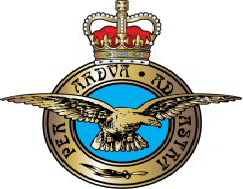
RAF Personal in Palembang POW Camps 1942 to 1945
For more information on the Deployment of the RAF in the Malay and Dutch East Indies, click on the link to Ronnies “Britain at War” page below.
On the 16th of February, HQ decided, due to the Japanese advance towards Singapore, that the relocation of bomber units to Sumatra was necessary and this began on the 18th of February.
255 Group HQ was set up in Palembang, the Aircraft and support personal were located at two airfields, Pangkalan Benteng (P1), some 10 Km North of Palembang and Prambumulih (P2), some 51 Km South West of Palembang.

Number 226 Fighter Group RAF arrived in Palembang, early February, transported to Sumatra by aircraft carrier with two Squadrons of Hawker Hurricanes, they were joind by the reminants of British, Australianan andNew Zealand squadrons from malay and Singapore with Hurricans and Brewster Buffalo aircraft.
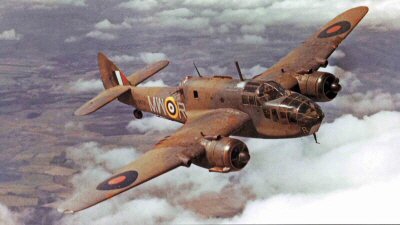
Bristol Beaufort

Hawker Hurricane
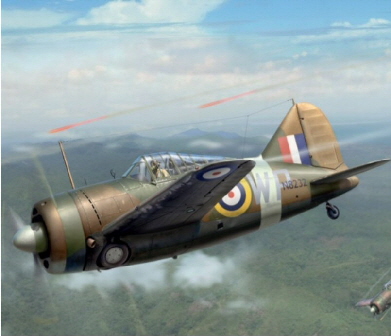
Bristol Buffalo
There was also a large contingant of the Royal Netherlands East Indies Army stationed at Palembang
.
 P2 Airfield Palembang, Sumatra P2 Airfield Palembang, Sumatra
The Battle of Palembang
The main objective of the Japanese invasion of the Duch East Indies, was to secure oil suplies. Palembang was a prime target due to the location of the large oil reineries at Pladjoe.
On the 13th of February, Japanes paratroopers landed at P1 airfield , the road linking P1 and Palembang and the oil refinery.The Japanese faild to take the P1 airfield but managed to sieze the oil refinery, a counterattack by the Netherland army retook the oil refinery but faild in an attempt to destroy it to prevent it being captured intact.
The main Japanes invasion force was made up of an amphibious assault fleet that had sailed from Cam Rahn Bay in French Indochina.
Capturing Bagka Island the Japanese mounted their assault on Palembang, Allied aircraft attacked the landing force, sinking one transport ship and straffingothers. On the 15th February, all aircraft were ordered to fly to Java.
The ground crews and other personnal were ordered to southern Sumatra and were evacuated from Oosthaven to Java
 Battle of Palembang Battle of Palembang
 Battle of Palembang video Battle of Palembang video
 The Japanes Airbourn Assault on P1 Aerdrome The Japanes Airbourn Assault on P1 Aerdrome
The men captured or surrendered, became the first POWs to be held in Palembang.
The realisation that Singapore was going to fall into Japanese hands resulted in senior commanders issuing orders for the evacuation of personnel and civilians. some were directed to the escape route across Sumatra to Padang.
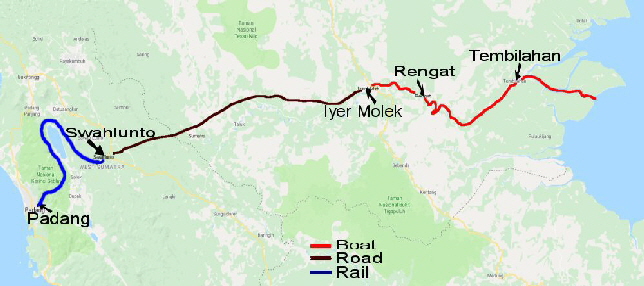
Escape route across Sumatra
Others boarded ships headed for Java, these ran into the Invasion force of the Japanese in the Bangka Straight, most of these ships were either sunk or captured.
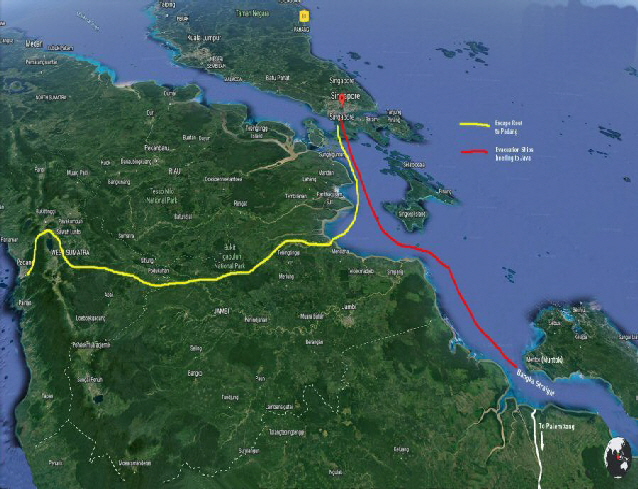
Escape route across Sumatra in Yellow
Evacuation route through Bangka Strait in Red
Michael Pether has done a tremendous ammout of work on the evacuation ships that left Singapore On the 13th of February 1942
 Evacuation Ships Evacuation Ships
Along with the men captured in Palembang and the RAF personal captured during the evacuation of Singapore, men started arriving in 1944 from the Dai Itchi camp at Pangkalan Bali, these men were originally in the Java Party 19 and were sent to Sungei Geron camp in Palembang suffering from severer dysentery and other tropical diseases, sadly, due to the diminishing supply of medicines and the shear exhaustion of the surgeions, Reed and Corcoran, many of these men died in Sungei Geron camp in Palembang and are included in the Roll. The Surviving men from Dai Itchi were transported to Singapore and were released from there at the end of the war.
The personnel capture in southern Sumatra were imprisoned in Palembag in Chung Wa School and Mulo School. The personnel capture during the evacuation of Singapore, when their ships were either sunk or captured in the Bangka Strait were held in Muntok on Bangka Island, some worked on an Airfield and then they were transported to the Palembang camps. The senior RAF Officer was Air Commodore Modin.
In early 1944 the POWs began moving to a new camp, Sungei Geron, outside of Palembang, the men were billeted in Attap Huts. Conditions in Sungei Geron were far worse than the previous camps, now contact with the native Sumatrans was more difficult and severally limited the men’s opportunities for trading with them.
An unsual prisoner in the Sungei Geron camp was Peter Henry John Elsee, of the No 3 Film Producton Unit SEAAF, captured on the 13th of August 1945 and released on the 18th of September 1945, just 28 days in captivity.
Eight Men flew out of Java in two Vildebeest aircraft when the Netherland army surrendered to the Japanese on the 8th of March 1942
.
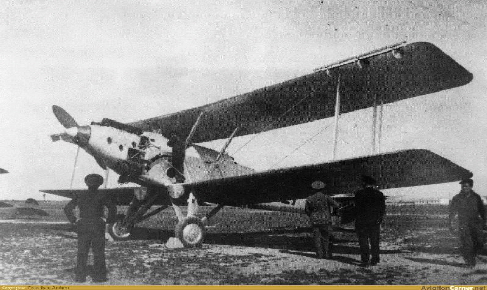
Vickers Vildebeest
One plane crash landed on Bencoolen, Sumatra five of the men were captured and taken to the POW camp in Sumatra. the other three men were lost presumed drowned
Flying Officer Lamb
Flying Officer Callick
Warrent Officer Peck.
On July the 18th 1942 a first draft of men were shipped to Singapore then onto Taiwan, with some ending up in Japan.
1st Draft from Palembang to Singapore
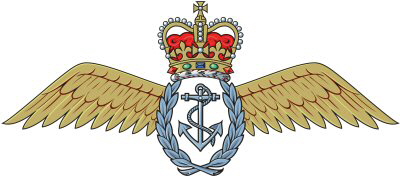
Fleet Air Arm
The British Pacific Fleet was formed in 1944, but the logistics of opperating a open Ocean carrier operation that the Americans had developed ment that the British fleet auxiliaries capable of supplying this type of operation had to be created from scratch. After desscusions with The American Admiral, Chester Nimitz, who sugested the British Pacific Fleet attack the oil refieries at Palembang, Admiral Sir Bruce Fraser agree, reasoning it would be a chance to prove its effectiveness.
At 6:15 the attack commenced, with Corsairs, Firefly and Avengers aircraft.
.
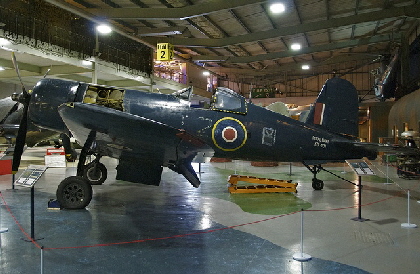
Fleet Air Arm Corsair
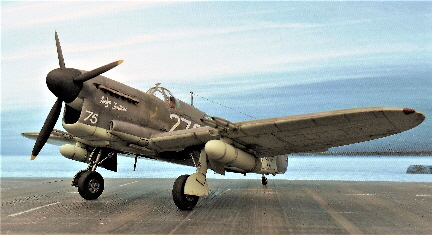
Firefly

Fleet Air Arm Avengers
Part of the operation was simultaneous attacks on the Japanese airfields, code named “Ramrod” to try and elimanate the Japanese aircraft on the ground.
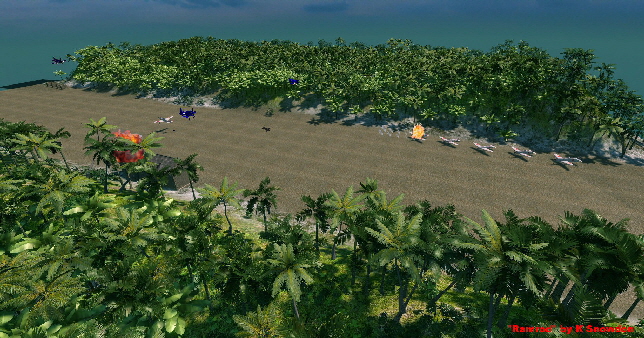
“Ramrod Attack on Japanese Airfields”
(Click on picture to enlarge)
The air attacks on the oil refineries was successful, production at Pladjoe and Sungei Geron was stopped until the end of March, the refineries never again reached full production. The British Pacific Fleet gained valuable experience, which they carried with them for the rest of the war, but it came with a terrible price of lost airmen, some killed outright in the attacks but some were shot down and survived nine others were captured by the Japanese and handed over to the Kempi Tai, they were later transferred to Singapore where they were executed.

The Palembang Nine Plaque at St Bartholomews Church in Yeovilton
Lt. John Haberfield - Pilot from 1839 Fighter Squadron (HMS Indomitable)
Lt. Evan John Baxter - Pilot from 1833 Fighter Squadron (HMS Illustrious)
S/Lt. Reginald James Shaw - Pilot from 1833 Fighter Squadron (HMS Illustrious)
Lt. Kenneth Morgan Burrenston - Crew from 849 TBR Squadron (HMS Victorious)
S/Lt. John Robert Burns - Crew from 849 TBR Squadron (HMS Victorious)
S/Lt. Donald V Roebuck - Crew from 849 TBR Squadron (HMS Victorious)
S/Lt. William Edwin Lintern - Crew from 849 TBR Squadron (HMS Victorious)
Petty Officer Ivor Barker - Crew from 849 TBR Squadron (HMS Victorious)
Petty Officer J S McRae - Crew from 849 TBR Squadron (HMS Victorious)
 The Palembang strikes Operation Meridian The Palembang strikes Operation Meridian
 Naval History Society Australia Operation Meridian Naval History Society Australia Operation Meridian
 HMS Illustrious Roll of Honour HMS Illustrious Roll of Honour
The Palembang raids resulted in a few bombs falling on the Sungei Geron camp, none of the POWs were injured but one Japanese guard was hit by shrapnel, the POWs cheered the raid, this infurated the Japanes resulting in the Royal Navy men being lined up, the Japanese demanded the ringleaders to come forward, no one move so the Japanese guards walked along the men lined up beating them with belt buckles, as the day dragged on one man stepped forward to take the blame, he recived a sever beating, but survived. In May 1945, the rest of the men from Dahi Itchi arrived, on route to Singapore. Joining them were most of the senior officers, including Commander Wills Sandford RAF and some other ranks, taking over as the camp senior officer was Captain Corrie.
Japanese Surrender
Dark days followed, rations were cut, men started to fall into depression, despratly seeking for anything to eat, it seemed as if the Japanese were trying eliminate the men.
Including the sick men from Dhai Itchi, the death rate increased dramatically, the men could not hold out much longer, an Officer had been informed the on the 27th of August the men were to be herded into a stockade and massacred.
In late August, camp working parties ceased, there was a notable change of attitude of the Japanese guards towards the POWs, one day the men were ordered to parade, the Japanese Commandant , Takahashi addressed the men through the interpreter, “Today we are all friends” , no acknowledgement that the war was over , it was up to Captain Corrie to confirm it, the war was finally over.
Supplies began to arrive including desperately needed medicines found in a wearhouse, unfortunately it was too late for some men. Some men from the RAMC, Captain Fordyce and Captain Mockler were parachuted in with additional medical supplies and food, undoubtedly they save many lives.
On the 17th of September, Commander J V Briggs RNVR along with Lieutenant Commander S Jenkins Liaison officer to Recovery of Allied Prisoners of War and Internees (R.A P W I )and Lieutenant Commander Spawl for war crimes investigation duties. Flying to Padang then onto Palembang, Commander Briggs was sent to investigate the best ways to evacuate the men from the camp back to Singapore, there were ships available, but he had to make sure the river and the Bangka Strait were clear of mines and he asked the Japanese for maps of any mining in those areas, he sent this report back to Singapore but was informed that plans to evacuate the men was to be carried out by aircraft (Dakota’s primarily).
Lady Louis Mountbatten arrived to tour the Hospital and camps and also to offer any help in organising the evacuation, she noted in her diary
"I spent nearly a week in Sumatra , the Japanese did what we told them and we eventually succeeded in the evacuation of British , Australian and India prisoners by boat and also by Dakota aircraft flown from hastily improvised airstrips , on the whole the evacuation went extraordinarily well considering the vast area covered , in Sumatra we evacuated all the Prisoners of war without a single allied soldier landed or the Navy lying of shore , luckily it worked and there is no doubt that had the war gone on just a few more weeks there would not have been any Prisoners of war left alive , they were absolutely on their last gasp and the tragedy is that so many did die in the last few weeks before surrender and even after it."
From Singapore the men would have been repatriated to the UK.
Ronnies FEPOW Family Repatriation page
 Repatriation Repatriation
RAF Units in the Palembang Camps
Research Notes
Thanks to
Jonathan Moffatt
Ronnie Taylor
Michael Pether
FEPOW Family Website
COFEPOW Website
Malay Volunteers
Muntok Memorial Peace Museum
WO 361/1948
WO 361/1947
WO 361/1946
Books
Unsung Heroes of the Royal Airforce by Les and Pam Stubbs
Prisoner of Nippon by Ray Stubbs
No Bamboo for Coffins by David Elio Roberts
Kevin Snowdon 2024
This Website is not public Domain
|